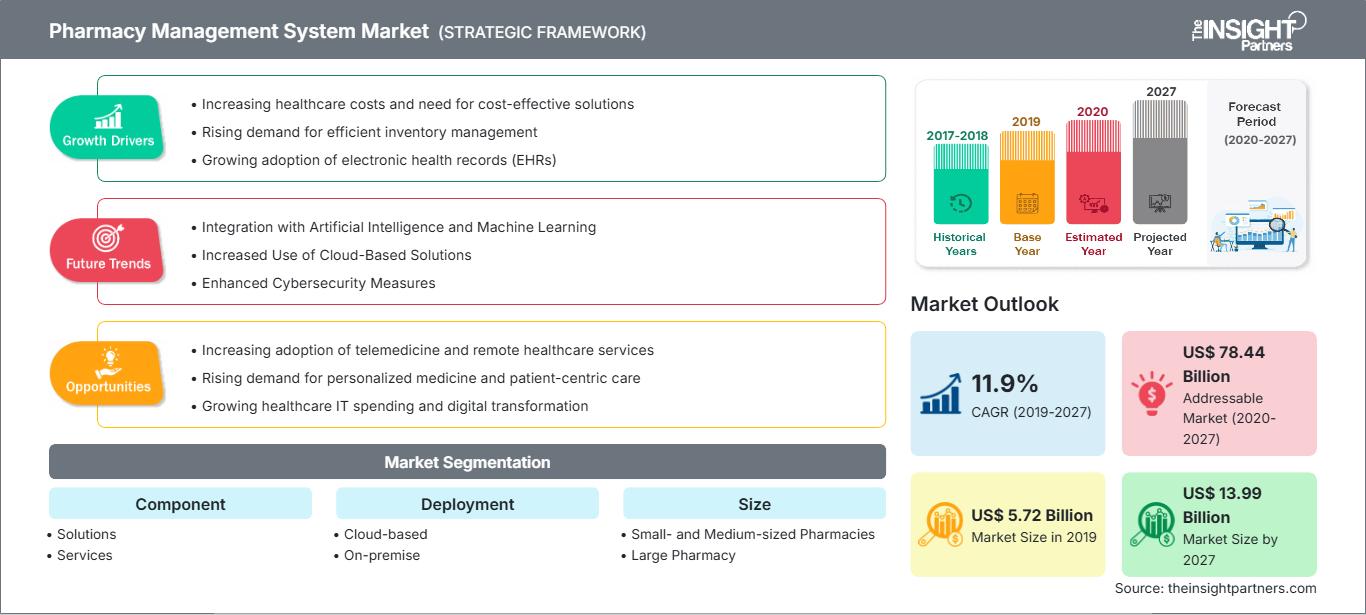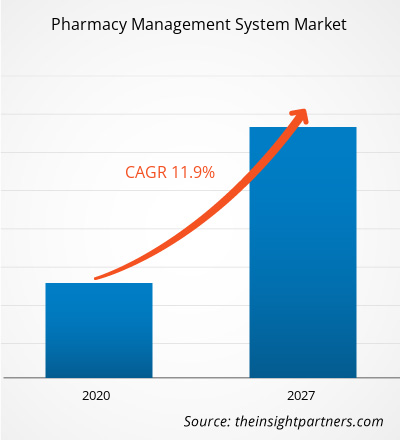Il mercato dei Sistemi di Gestione Farmacia è stato valutato a 5.724,82 milioni di dollari nel 2019 e si prevede che raggiungerà i 13.985,27 milioni di dollari entro il 2027; si prevede una crescita a un CAGR dell'11,9% dal 2020 al 2027.
Un sistema di gestione della farmacia è uno strumento importante dotato di sistemi di gestione della farmacia potenti e intuitivi. Il sistema di gestione della farmacia aiuta i farmacisti a gestire le complessità della dispensazione dei farmaci, degli inventari dei farmaci e delle funzioni del punto vendita. Inoltre, aiuta a elaborare, tracciare e dispensare i farmaci prescritti con maggiore sicurezza, precisione ed efficienza. La crescita del mercato dei Sistemi di Gestione Farmacia è attribuita allo sviluppo dell'IT sanitario e si prevede che il crescente numero di farmacie in tutto il mondo stimolerà la crescita del mercato nel corso degli anni. Tuttavia, è probabile che le limitazioni associate ai sistemi di gestione delle farmacie abbiano un impatto negativo sulla crescita del mercato nei prossimi anni.
Si prevede che il mercato dei sistemi di gestione delle farmacie registrerà una crescita sostanziale dopo la pandemia. Il COVID-19 ha colpito economie e settori in diversi paesi a causa di lockdown, divieti di viaggio e chiusure aziendali. La crisi del COVID-19 ha sovraccaricato i sistemi sanitari pubblici in molti paesi e ha evidenziato la forte necessità di investimenti sostenibili nei sistemi sanitari. Con il progredire della pandemia di COVID-19, si prevede un calo della crescita del settore sanitario. Il segmento delle scienze della vita prospera grazie alla crescente domanda di prodotti diagnostici in vitro e alle crescenti attività di ricerca e sviluppo in tutto il mondo. Tuttavia, il segmento delle tecnologie mediche e dell'imaging sta registrando un calo delle vendite a causa del minor numero di interventi chirurgici eseguiti e del ritardo o del prolungamento dell'approvvigionamento delle attrezzature. Inoltre, si prevede che le consulenze virtuali da parte degli operatori sanitari diventeranno il modello di erogazione dell'assistenza sanitaria tradizionale dopo la pandemia. Con la telemedicina che sta trasformando l'erogazione dell'assistenza, la salute digitale continuerà a prosperare nei prossimi anni. Inoltre, si prevede che l'interruzione degli studi clinici e il conseguente ritardo nel lancio dei farmaci apriranno la strada a sperimentazioni completamente virtuali in futuro. Si prevede che nuove tecnologie come l'mRNA emergeranno e rivoluzioneranno l'industria farmaceutica e il mercato, che nei prossimi anni assisterà a una maggiore integrazione verticale e a joint venture.
Personalizza questo rapporto in base alle tue esigenze
Potrai personalizzare gratuitamente qualsiasi rapporto, comprese parti di questo rapporto, o analisi a livello di paese, pacchetto dati Excel, oltre a usufruire di grandi offerte e sconti per start-up e università
Mercato dei sistemi di gestione della farmacia: Approfondimenti strategici

- Ottieni le principali tendenze chiave del mercato di questo rapporto.Questo campione GRATUITO includerà l'analisi dei dati, che vanno dalle tendenze di mercato alle stime e alle previsioni.
Potrai personalizzare gratuitamente qualsiasi rapporto, comprese parti di questo rapporto, o analisi a livello di paese, pacchetto dati Excel, oltre a usufruire di grandi offerte e sconti per start-up e università
Mercato dei sistemi di gestione della farmacia: Approfondimenti strategici

- Ottieni le principali tendenze chiave del mercato di questo rapporto.Questo campione GRATUITO includerà l'analisi dei dati, che vanno dalle tendenze di mercato alle stime e alle previsioni.
Approfondimenti di mercato
Le crescenti applicazioni dei sistemi di gestione della farmacia nel settore sanitario guideranno la crescita del mercato dei sistemi di gestione della farmacia
La spesa sanitaria è in costante aumento nella maggior parte dei paesi del mondo. Sono stati identificati molteplici fattori che contribuiscono allo sviluppo del settore sanitario in questi paesi, e gli sviluppi rapidi e costanti relativi all'applicazione delle tecnologie dell'informazione (IT) in questo settore sono stati un fattore determinante. Negli ultimi due decenni, le tecnologie dell'informazione hanno svolto un ruolo chiave nel lavoro di milioni di persone e hanno contribuito al miglioramento di vari settori industriali, tra cui quello sanitario. Molti utenti finali, medici prescrittori e farmacisti, hanno abbracciato i vantaggi dell'automazione. L'utilizzo di soluzioni IT ha consentito l'archiviazione delle cartelle cliniche dei pazienti in un formato strutturato; ha inoltre contribuito a regolarizzare l'implementazione delle prescrizioni elettroniche, risparmiando così una notevole quantità di carta, semplificando il processo di somministrazione e dispensazione dei farmaci e automatizzando la gestione dei medicinali lungo la catena di approvvigionamento. In definitiva, ha contribuito a migliorare la sicurezza dei pazienti e a fornire un'assistenza di alta qualità per aiutarli a trarre il massimo beneficio dai loro farmaci.
Le agenzie governative di tutto il mondo stanno adottando diversi piani d'azione per rimodellare le farmacie tradizionali e attuali, al fine di sfruttare al meglio le competenze uniche dei farmacisti, abbinate all'implementazione dell'IT. Ad esempio, il Ministero della Salute di Wellington, in Nuova Zelanda, ha introdotto un Piano d'Azione per le Farmacie 2016-2020 che descrive una gamma di servizi nuovi e avanzati che le farmacie dovranno offrire attraverso l'utilizzo di nuovi sistemi di gestione delle farmacie. Inoltre, la digitalizzazione e l'automazione della gestione delle scorte e dei depositi hanno contribuito a semplificare il processo di approvvigionamento in grandi catene di farmacie, come Wallgreens, Apollo e CVS. Pertanto, si prevede che tali progressi nell'IT sanitario continueranno a stimolare la crescita del mercato delle soluzioni di gestione delle farmacie nei prossimi anni.
Il numero di farmacie pro capite è in rapida crescita a livello globale. Secondo l'Organizzazione per la Cooperazione e lo Sviluppo Economico (OCSE), il numero totale di farmacie e farmacisti è aumentato del 30% tra il 2000 e il 2015 nei paesi OCSE. Tra i paesi sviluppati, il Giappone registra la più alta densità di farmacisti, grazie agli sforzi del governo per la separazione della dispensazione, ovvero l'eliminazione della dipendenza tra la prescrizione dei farmaci da parte dei medici e la dispensazione dei farmaci da parte dei farmacisti, aumentando i margini di profitto per i farmacisti e il numero di farmaci e forniture mediche nel paese. La tendenza all'aumento del numero di farmacie è stata osservata anche in Australia. Secondo la Pharmacy Guild of Australia 2017 e l'IBIS 2018, nel 2018 si è registrato un aumento del 30,6% dei ricavi del Pharmaceutical Benefits Scheme (PBS) e un aumento del 6% delle farmacie aperte al pubblico rispetto agli ultimi 5 anni.
La crescita del numero di farmacie è attribuita all'aumento delle vendite di medicinali e prodotti farmaceutici, all'invecchiamento demografico, alla crescente implementazione di programmi per la somministrazione di farmaci da prescrizione, all'aumento del numero di brevetti in scadenza che aprono la strada all'immissione sul mercato di nuovi farmaci generici e all'aumento dell'incidenza di nuove malattie tra i pazienti.
Ciò ha portato a un aumento della domanda di forniture farmaceutiche e farmaci, con conseguente apertura di nuove farmacie e espansione di catene di farmacie esistenti. Con i progressi tecnologici, le farmacie di nuova apertura stanno integrando strumenti di gestione intelligenti, come i sistemi di gestione farmaceutica, per semplificare e rendere più sofisticato il processo di distribuzione.
Approfondimenti basati sui componenti
In termini di componenti, il mercato dei sistemi di gestione farmaceutica è segmentato in soluzioni e servizi. Il segmento delle soluzioni ha detenuto la quota maggiore del mercato nel 2019.
Approfondimenti basati sull'implementazione
In base all'implementazione, il mercato dei sistemi di gestione farmaceutica è segmentato in cloud e on-premise. Il segmento on-premise ha detenuto la quota maggiore del mercato nel 2019.
Approfondimenti basati sulle dimensioni
In termini di dimensioni, il mercato dei Sistemi di Gestione della Farmacia è segmentato in farmacie di piccole e medie dimensioni e grandi farmacie. Il segmento delle grandi farmacie ha detenuto la quota maggiore del mercato nel 2019.
Gli operatori del mercato dei Sistemi di Gestione della Farmacia stanno adottando strategie di lancio ed espansione dei prodotti per soddisfare le mutevoli esigenze dei clienti in tutto il mondo, il che consente loro anche di mantenere il proprio marchio a livello globale.
Mercato dei sistemi di gestione delle farmacie
Le tendenze regionali e i fattori che influenzano il mercato dei sistemi di gestione della farmacia durante il periodo di previsione sono stati ampiamente spiegati dagli analisti di The Insight Partners. Questa sezione illustra anche i segmenti e la geografia del mercato dei sistemi di gestione della farmacia in Nord America, Europa, Asia-Pacifico, Medio Oriente e Africa, America meridionale e centrale.
Ambito del rapporto di mercato del sistema di gestione della farmacia
| Attributo del rapporto | Dettagli |
|---|---|
| Dimensioni del mercato in 2019 | US$ 5.72 Billion |
| Dimensioni del mercato per 2027 | US$ 13.99 Billion |
| CAGR globale (2019 - 2027) | 11.9% |
| Dati storici | 2017-2018 |
| Periodo di previsione | 2020-2027 |
| Segmenti coperti |
By Componente
|
| Regioni e paesi coperti | Nord America
|
| Leader di mercato e profili aziendali chiave |
|
Densità degli operatori del mercato dei sistemi di gestione delle farmacie: comprendere il suo impatto sulle dinamiche aziendali
Il mercato dei sistemi di gestione delle farmacie è in rapida crescita, trainato dalla crescente domanda degli utenti finali, dovuta a fattori quali l'evoluzione delle preferenze dei consumatori, i progressi tecnologici e una maggiore consapevolezza dei benefici dei prodotti. Con l'aumento della domanda, le aziende stanno ampliando la propria offerta, innovando per soddisfare le esigenze dei consumatori e sfruttando le tendenze emergenti, alimentando ulteriormente la crescita del mercato.

- Ottieni il Mercato dei sistemi di gestione della farmacia Panoramica dei principali attori chiave
Mercato dei sistemi di gestione della farmacia - per componente
- Soluzione
- Gestione dell'inventario
- Gestione degli ordini di acquisto
- Gestione della catena di fornitura
- Informazioni normative e di conformità
- Prestazioni cliniche e amministrative
- Altre soluzioni
- Servizi
Mercato dei sistemi di gestione della farmacia - per distribuzione
- Basato su cloud
- In sede
Mercato dei sistemi di gestione della farmacia - per dimensione
- Farmacie di piccole e medie dimensioni
- Grandi farmacie
Mercato dei sistemi di gestione della farmacia - per dimensione- Farmacie di piccole e medie dimensioni
- Farmacie di grandi dimensioni ... per area geografica
America settentrionale
- Stati Uniti
- Canada
- Messico
Europa
- Francia
- Germania
- Italia
- Regno Unito
- Spagna
- Resto d'Europa
Asia Pacifico (APAC)
- Cina
- India
- Corea del Sud
- Giappone
- Australia
- Resto dell'APAC
Medio Oriente e Asia. Africa (MEA)
- Sudafrica
- Arabia Saudita
- Emirati Arabi Uniti
- Resto del MEA
Sud America e America Centrale (SCAM)
- Brasile
- Argentina
- Resto dello SCAM
Profili aziendali
- Microsoft
- Koninklijke Philips NV
- Intel Corporation
- General Electric Company
- Alphabet Inc.
- NVIDIA CORPORATION
- Nuance Communications, Inc.
- Siemens Healthineers AG
- Arterys Inc.
- Johnson & Johnson Services, Inc.
- Analisi storica (2 anni), anno base, previsione (7 anni) con CAGR
- Analisi PEST e SWOT
- Valore/volume delle dimensioni del mercato - Globale, Regionale, Nazionale
- Industria e panorama competitivo
- Set di dati Excel
Report recenti
Rapporti correlati
Testimonianze
Motivo dell'acquisto
- Processo decisionale informato
- Comprensione delle dinamiche di mercato
- Analisi competitiva
- Analisi dei clienti
- Previsioni di mercato
- Mitigazione del rischio
- Pianificazione strategica
- Giustificazione degli investimenti
- Identificazione dei mercati emergenti
- Miglioramento delle strategie di marketing
- Aumento dell'efficienza operativa
- Allineamento alle tendenze normative




















 Ottieni un campione gratuito per - Mercato dei sistemi di gestione della farmacia
Ottieni un campione gratuito per - Mercato dei sistemi di gestione della farmacia